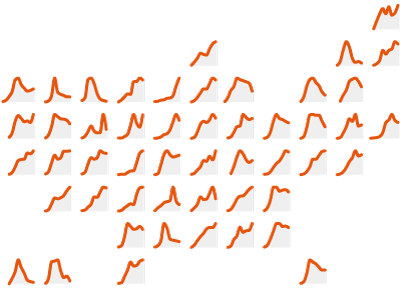The United States suffered several waves of COVID-19 with a total of lives lost since early 2020. At the peak of the U.S. epidemic in January 2021, over 3,300 people died on average each day. A total of cases have been reported, according to a Reuters analysis of state and county data.
The widespread availability of vaccines in the United States helped to reduce cases in the spring and early summer. But the Delta variant led to a renewed spike in cases and hospitalizations nationwide later in the year. In December of 2021, daily COVID-19 cases in the U.S. climbed to record highs due to the fast-spreading Omicron variant.
Click here to see infections, deaths and vaccination rates worldwide.
See the charts below for detailed data on the daily and weekly rate of new cases, deaths, hospitalizations and vaccinations in each state.
Editor’s note
As of July 27, reports of COVID-19 cases and deaths are sourced to Reuters reporting in order to streamline data reconciliation efforts when discrepancies arise. Testing data continues to come from The COVID Tracking Project.
About the data: On March 1, 2021, this page stopped using new hospitalization and testing data from The COVID Tracking Project in anticipation of that project’s end. The hospitalization data shown here was collected by Reuters after August 1, 2020. The previous data comes from The COVID Tracking Project’s archives.
The vaccination data comes from the Centers for Disease Control and Prevention.
Reuters collates and checks this data by hand and the figures largely come from state, county and territory government/public health department websites. Reuters also occasionally sources information from press conferences, press releases and verified tweets and social media posts by state officials. While some states and counties report fresh numbers daily, others only update on weekdays or less frequently.
Reuters’ total cases and deaths include both confirmed and probable cases and deaths where data is available. If probable cases and deaths are not reported, only confirmed cases and deaths are shown.
Alabama reported a backlog of tests May 14-15, 2021, which resulted in a one-time spike in cases.
On April 7, 2021, Oklahoma reported 1,716 new deaths that occurred between August and February that had gone unreported due to an error by a lab.
A change in reporting methodology in Iowa on Feb. 19 resulted in a one-time increase of over 27,000 new cases.
A spike observed in deaths in Ohio and nationally in early February 2021 is due to Ohio including 4,275 probable deaths from earlier in the pandemic.
A spike observed in deaths in Indiana and nationally in early February 2021 is due to Indiana including over 1,500 probable deaths from earlier in the pandemic.
Missouri cases and deaths for the week ended Jan. 31 include a one-time increase due to Reuters including data reported by St. Louis County.
Texas began reporting probable cases on Dec. 11. The change resulted in a one-day increase of roughly 65,000 cases.
On Sept. 2, Massachusetts adopted a more restrictive definition for probable cases, which resulted in a significant fall in the number of cases. Reuters has reconciled all historical data to reflect this change in methodology
Virginia reported a large backlog of positive infections on Aug. 7, resulting in an abnormal spike in cases.
On July 30, Minnesota began reporting the total number of people tested instead of total specimens tested. This changed the state total by more than 173,000 tests for July 31.
A spike observed in deaths in New Jersey and nationally in late June is due to New Jersey including over 1,800 probable deaths from earlier in the pandemic.
Wyoming’s spike in late April is due to the inclusion of probable cases.
New cases in Alabama more than doubled to 7,787 in late March but this included a backlog.
Reporting by Roshan Abraham, Shaina Ahluwalia, Kavya B, Christine Chan, Chaithra J, Anurag Maan, Sangameswaran S and Lisa Shumaker,
Sources: Vaccination data is from the Centers for Disease Control and Prevention; Deaths, cases and hospitalization data is from state and local governments, health authorities and Reuters reporting; Hospitalization data prior to August 1, 2020 is from The COVID Tracking Project
Graphic by Chris Canipe and Lisa Shumaker
Editing by Tiffany Wu



